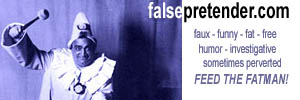Considerable Sounds: Igor's Boogie
My childhood was a period of waiting for the moment when I could send everyone and everything connected with it to hell. -Igor Stravinsky
Le Sacre Du Printemps
Igor Stravinsky's Rite of Spring inspired and infected everything that followed it (depending on your perspective). Certainly it revolutionized music at its introduction. (Actually, the radical unparalleled piece was not received well at its opening, inciting riots and called "fiendish" by the Boston Herald). But since that time, Stravinsky's masterpiece has been recognized by both critics and audiences as a musical work of art. And truly, a start to a new era in music.What made Stravinsky's Le Sacre Du Printemps (The Rite of Spring) so different from everything else?
Musically or Otherwise....
 The Scandalous Stravinsky And Nijinsky
The Scandalous Stravinsky And Nijinsky
 The Scandalous Stravinsky And Nijinsky
The Scandalous Stravinsky And NijinskyMusically there's a curious little passage that is a bit like "dangling participle" near the end of the opening bassoon solo - a descending diminished third followed by a rising augmented fourth. This is greatly expanded upon during the Pastoral introduction, so that by the time the bassoon solo re-enters, that little theme has grown into something that fills the hall, the mind , and the soul with sound. None of these permutations could have been foreseen, back at measure 5!
This alone strikes me as the genius of Stravinsky, let alone the rhythmic and orchestration leaps into uncharted territory.
While it's not atonal music by any stretch of the imagination, it's grounded in scales that are very different from those in the major-minor tonal system. This doesn't end up sounding very much like Brahms. Then when you couple that with his rhythms (Stravinsky may have been the greatest inventor of rhythms who ever lived), you've got something truly new and different.The score is not likely a representation of DNA, or anything like that. But the way the piece grows "organically" from little snippets of information, which end up yielding huge constructions that couldn't have been foreseen is perhaps a musical parallel.
I am in the present. I cannot know what tomorrow will bring forth. I can know only what the truth is for me today. That is what I am called upon to serve, and I serve it in all lucidity. -Igor Stravinsky
I have 63 recordings of the damned thing. This documents pretty well, I think, the fact that a performing tradition has grown up around the piece, and orchestras now seem a bit more adept at handling the complexities. My personal all time favorite is the 1958 New York Philharmonic version with Leonard Bernstein conducting. This is a fiery inspired performance that captures the spirit of the piece and also is a remarkably good recording (one of the earliest orchestral recordings using multi microphones, particularly effective in the percussion section). I don’t believe this document has been surpassed….yet. Stravinsky’s own reaction to this performance was one word, “Wow”.
Surprisingly, my least favorite is the one Stravinsky actually conducted himself in 1960. Stravinsky by this time had enveloped himself in neo-classicism and I suppose interpreted his previous work with the aesthetics of convention in mind..
I would imagine the tempos are probably correct, but the fire just isn’t there.
David Goza is Associate Professor of Music at Drury University and founding conductor/music director of the Chamber Orchestra of the Ozarks who recently performed this masterpiece. He was asked on a web forum what his personal favorite performance of this work was. He had once played oboe for the Memphis Symphony and related this story.
“Easter Sunday one year. The following Tuesday, the local paper was filled with angry letters to the editor about our bad taste -programming such pagan nonsense on the holiest day of the year... A week later, a small tornado came through downtown Memphis, taking the roof off the auditorium... The following Tuesday, the letters to the editor page was again filled, this time with pronouncements of the wrath of God.”
 The set was painted by Nicholas Roerich.
The set was painted by Nicholas Roerich.Roerich's stage-designs for the premiere of Igor Stravinsky's The Rite of Spring, given in Paris in 1913, and based on ancient Russian motifs, were highly innovative and influential. They were an important element in the success and the scandal of this epochal musical event.
Or Otherwise
Stravinsky came up with the idea for the piece in 1910 based on fantasy. A vision of a pagan ritual in which a young girl dances herself to death. While composing The Firebird, Stravinsky began forming sketches and ideas for the piece, enlisting the help of archaeologist and folklorist Nikolai Roerich. Though he was sidetracked for a year while he worked on Petrushka (which he intended to be a light burlesque as a relief from the orchestrally-intense work already in progress), The Rite of Spring was composed between 1912 and 1913 for Serge Diaghilev's Ballets Russes. Roerich was an integral part of the creation of the work, drawing from scenes of historical rites for inspiration; Stravinsky referred to the work-in-progress as "our child". After going through revisions almost up until the very day of its first performance, it was premiered on May 29, 1913 at the Théâtre des Champs-Élysées in Paris and was conducted by Pierre Monteux. Stravinsky would later write that a better translation to English would have been "The Coronation of Spring."
The Ballets Russes staged the first performance. The intensely rhythmic score and primitive scenario—a setting of scenes from pagan Russia—shocked audiences more accustomed to the demure conventions of classical ballet. Vaslav Nijinsky's choreography was a radical departure from classical ballet. Gone were the long and graceful lines of traditional ballet, arms and legs were sharply bent. The dancers danced more from their pelvis than their feet, (a style that later influenced Martha Graham). Stravinsky would later write in his autobiography of the process of working with Nijinsky on the choreography, writing: "the poor boy knew nothing of music" and that Nijinsky "had been saddled with a task beyond his capacity." While Stravinsky praised Nijinsky's amazing dance talent, he was frustrated working with him on choreography.
Generally speaking, dancers have a tough time with time signatures outside the common
2\4, 3\4, 4\4, and 6\8 designations even today, as evidenced in Phillip Glass - Twila Tharp collaboration in “Einstein on the Beach”. Glass kept explaining to the dancers that 5\4 was like a bar of 3\4\followed by a bar of 2\4.
Listen to the complete Rite Of Spring on NPR by clicking here.
The Premiere
The complex music and violent dance steps depicting fertility rites first drew catcalls and whistles from the crowd. At the start with the opening bassoon solo, the audience began to boo loudly due to the slight discord in the background notes behind the bassoon's opening melody. There were loud arguments in the audience between supporters and opponents of the work. These were soon followed by shouts and fistfights in the aisles. The unrest in the audience eventually degenerated into a full fledged major riot. The Paris police arrived by intermission, but they could restore only limited order. Chaos reigned for the remainder of the performance, and Stravinsky himself was so upset on account of its reception that he fled the theater in mid-scene, reportedly crying. Fellow composer Camille Saint-Saëns famously stormed out of the première, (though Stravinsky later said in his biography "I do not know who invented the story that he was present at, but soon walked out of, the premiere.") allegedly infuriated over the "misuse" of the bassoon in the ballet's opening bars.
Stravinsky ran backstage, where Diaghilev was turning the lights on and off in an attempt to try to calm the audience. Nijinsky stood on a chair, leaned out (far enough that Stravinsky had to grab his coat-tail), and shouted numbers to the dancers, who couldn't hear the orchestra over the rioting audience (this was challenging because Russian numbers are polysyllabic above ten, such as eighteen: vosemnadsat).
Although Nijinsky and Stravinsky were despondent, Diaghilev (a Russian art critic as well as the ballet's impresario) commented that the scandal was "just what I wanted".
The music and choreography were considered barbaric and sexual and are also often noted as being the primary factors for the cause of the riot, but many political and social tensions surrounding the premiere may have contributed to the backlash as well. Even though Nijinsky's original choreography was lost, the work is now a standard of dance troupes around the world and has been choreographed by Pina Bausch and Sir Kenneth MacMillan.
The ballet completed its run of six performances amid controversy, but experienced no further disruption. The same performers gave a production of the work in London later the same year. Both Stravinsky and Nijinsky continued to work, but neither created pieces in this percussive and intense style again. The United States premiere was in 1924 in a concert (that is, non-staged) version. It could be argued that audiences were capable of accepting the music on it’s own terms but when combined with the multi media experience of the sets and choreography were simply not able to handle it.
The Rite of Spring is often referred to as a modernist work but one could indeed argue that it was a return to primitivism. Much like Pablo Picasso ’s work in the visual arts. Whichever way you might see this piece, there can be no argument that it was and continues to be nothing short of revolutionary.
“My God, so much I like to drink Scotch that sometimes I think my name is Igor Stra-whiskey.” -Igor Stravinsky
Duly Consider and Considerable Sounds are TM of this publication and are subject to liabilities thereof










1 comment:
It would be interesting to have a listing of all music acts which have cause riots. One now seemingly innocuous artist who had this "problem": Fats Domino
Post a Comment